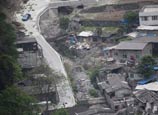
TO THE RESCUE
In contrast to the disaster in Wenchuan in 2008, when people largely turned to TV programs and Internet news for updates on the relief, more people are obtaining and spreading latest reports on the Lushan quake via Sina Weibo and WeChat, available via mobile phones and computers.
Social media is thus shunning the trivial associations with which many have lumbered it. Weibo and WeChat have become equally powerful with field rescue forces, as China claims over 500 million Sina microblog subscribers and over 300 million WeChat subscribers. In 2010, China had only 50 million Sina microblog subscribers, and Wechat did not even exist.
Locating people is a primary function of social media in quake relief. An hour and 40 minutes after the quake, Fang Yuan, a 26-year-old staffer at Sina.com Chongqing's branch, registered an online platform under the name @Ya'anxunren, or "Ya'an Search People" with Sina's microblog service designed to help people find families and friends in quake-hit areas.
Fang said, "I saw people sending all sorts of microblog messages searching for people losing contact and seeking help after the quake. There was confusion in microblogs, as too many people had conflicting opinions. We thus needed a unified platform to get information lined up."
Countless messages were forwarded on @Ya'anxunren, and many people were located in a few hours, according to the platform's creator.
With 14 hours of the quake, Sina microblogs had sent three million messages helping people in search of families. Victims also directed rescue workers to the exact sites where they were trapped with mobile phone text messages.
One pre-existing people-search online forum that has won acclaim since April 20 is "Chengdu Bar". Posted via Sina Weibo, this microblog features continually added names and addresses, and has been forwarded over 1,000 times, attracting 240,000 readers, since the quake.
Internet search engine Baidu said it helped locate six people on April 21, and Tencent that it assisted 101 people to get into contact with their families using people-search platforms on the same day.
Kan Kaili, a professor with Beijing University of Posts and Telecommunications, said, "Phone calls increased sharply after the quake, which often jammed the communications channel. Microblogs and WeChat, using the data channel, could soundly avoid these jams, and thus show great strength in disaster relief in the new media era."
In addition, social media has served to maintain order in disaster relief. Microblog users, for instance, called on regular drivers to avoid the Chengdu-Ya'an Expressway, the fastest route to quake-hit areas, to facilitate rescue workers getting in faster.
Social media has also contributed donations for disaster relief. Tencent and Internet company Netease have reported receiving a combined five million yuan in donations online. The One Foundation has gathered 15 million yuan in donations, with 12 million yuan coming via the Internet.


















 Local villagers climb mountains to get relief supplies
Local villagers climb mountains to get relief supplies


![]()
